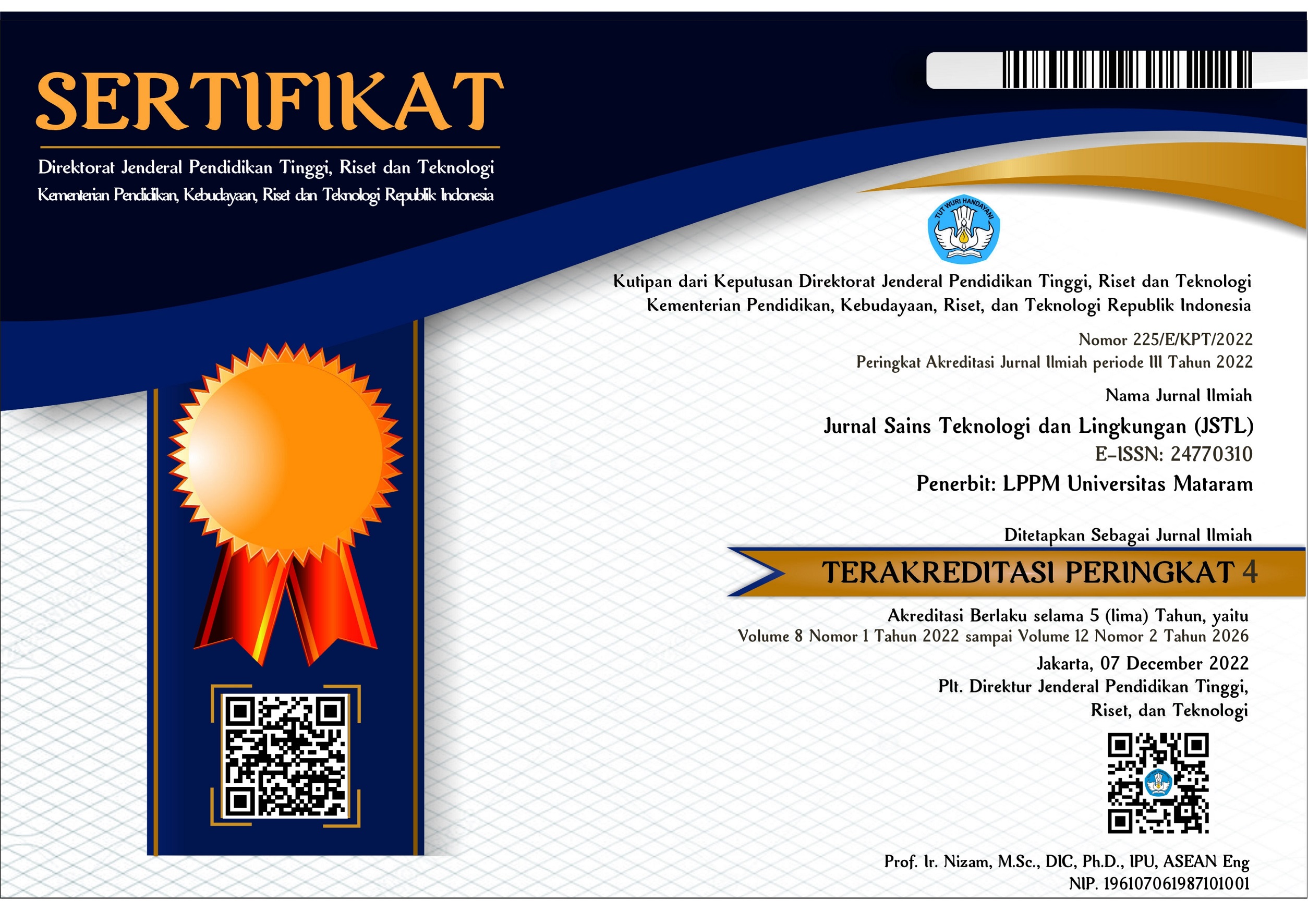Efektivitas Pupuk Hayati Bactoplus dalam Meningkatkan Efisiensi Pemupukan NPK pada Tanaman Kentang (Solanum tuberosum L.) Varietas Chitra
Effectiveness of Bactoplus Biofertilizer in Increasing the Efficiency of NPK Fertilizer on Potato Plant (Solanum tuberosum L.) Chitra Variety
DOI:
https://doi.org/10.29303/jstl.v9i3.472Keywords:
Pseudomonas fluorescences, Bacyllus endophyticus, Trichoderma, inorganic fertilizer, organic fertilizerAbstract
This study was undertaken to examine the effectiveness of Bactoplus biofertilizer in increasing the efficiency of NPK fertilization on potato of Chitra variety. The experiment used a two-factor factorial randomized block design, namely: doses of NPK fertilizer (N1= 650 kg ha-1 /100% of the recommendation; N2= 487.5 kg ha-1/75% of the recommendation; and N3= 325 kg ha-1/50% of the recommendation) and Bactoplus biofertilizer (H0 = without Bactoplus biofertilizer and H1 = with Bactoplus biofertilizer). The results showed that the biofertilizer Bactoplus was effective in increasing the efficiency of NPK fertilizer, particularly to plant height at 3 weeks after planting (MST) and number of leaves at 7 MST. At the same dosages of NPK fertilizer, application of biofertilizer increased the plant height at 3 MST and the number of leaves at 7 MST, The best growth was achieved when the plants was treated with 75% of NPK in combination with Bactoplus application. The effect of each factor showed that application of Bactoplus biofertilizer increased growth, yield and quality of potato tubers. In adition, the dose of NPK fertilizer affected the growth of potato plants but did not affect the yield and quality of potato tubers.References
Badan Pusat Statistika 2022. Produksi Tanaman Sayuran 2022. https://www.bps.go.id/site/resultTab. [8 September 2022].
BMKG Nusa Tenggara Barat. 2023. Buletin informasi iklim. http://www.BMKG.go.id/. [12 Maret 2023].
Cahyani, K.I., Sudana I.M., dan Wijana, G. 2021. Pengaruh jenis Trichoderma spp. Terhadap Pertumbuhan, Hasil, dan Keberadaan Penyakit Tanaman Kacang tanah (Arachis hypogaea L.). Jurnal Agrotrop. 11: 40-49.
Husen, S., Sutardjo, H.T., Zakia, A., Purnomo, A.E., dan Nurfitriani, R. 2021. Teknologi Produksi Tanaman Sayuran. Universitas Muhammadiyah Malang. Malang. 218 h.
Lumbangaol, P. 2011. Pedoman Pembuatan Dosis Pupuk Kelapa Sawit. Musim Emas. Medan.
Khan, Z., Doty, S.L. 2009. Characterization of bacterial endophytes of sweet potato plants. Plant Soil 322:197–207. https://doi.org/10.1007/s11104-009-9908-1
Maryanto, M.A., Sukiyono, K., dan Priyono, B.S. 2018. Analisis Efisiensi Teknis dan Faktor Penentunya pada Usahatani Kentang (Solanum tuberosum L.) di Kota Pagar Alam, Provinsi Sumatera Selatan. Agraris 4 (1): 1-8. https://doi.org/ 10.18196/agr.4154
Masganti, Simatupang, R.S., Alwi, M., Maftu’ah, E., Noor, M., Mukhlis., Sosiawan, H., dan Susanti, M.A. 2018. Inovasi teknologi lahan rawa mendukung kedaulatan pangan. Rajawali Press.Depok.
Pankievicz, V.C.S., Irving, T.B., Maia, L.G.S. and Ane, J.M. 2019. Are we there yet? The long walk towards the development of efficient symbiotic associations between nitrogen-fixing bacteria and non-leguminous crops. BMC Biol 17: 99 https://doi.org/10.1186/s12915-019-0710-0
Pérez-Álvarez, S., Ardisana, E.F.H., Magallanes-Tapia, M.A., et al.. 2022. Microorganisms Used as Growth Regulators in Modern agriculture. In: Prasad, R., Zhang, SH. (eds) beneficial microorganisms in agriculture. Environmental and Microbial Biotechnology. Springer, Singapore. https://doi.org/10.1007/978-981-19-0733-3_2
Rahayu, E.D. 2022. Pertumbuhan dan hasil tanaman kentang (Solanum tuberosum L.) varietas Chitra di kecamatan Sembalun pada musim dan ketinggian tempat yang berbeda. Skripsi Fakultas Pertanian Universitas Mataram, Mataram.
Santosa, M. 2019. Budidaya kentang dataran tinggi dan dataran medium di lahan tropis. UB Press. Malang.
Sembiring, L.J. 2022. Impor kentang RI anjlok 83% pada awal tahun. https://www.cnbcindonesia.com/news/20220307171101-4-320709/impor-kentang-ri-anjlok-83-pada-awal-tahun [21 September 2022].
Setiawati, M.R. 2014. Peningkatan kandungan N dan P Tanah serta hasil padi sawah akibat aplikasi Azolla pinnata dan pupuk hayati Azotobacter chroococcum dan Pseudomonas cepaceae. Jurnal Agrologia. 3: 28-36.
Siregar, R. 2015. Efektivitas pemberian pupuk hayati bactoplus dan pupuk kotoran sapi terhadap pertumbuhan dan produksi tanaman sawi manis (Brassica sinensis L.). Skripsi Fakultas Pertanian Universitas Medan Area, Medan.
Statistik Konsumsi Pangan 2020. Survey sosial ekonomi nasional 2020. https://satudata.pertanian.go.id/assets/docs/publikasi/Buku_Statistik_Konsumsi_2020.pdf [8 September 2022].
Subardja, V.O., dan Sudjana, B. 2015. Pengomposan limbah organik oleh Aspergilus sp. untuk ameliora padi sawah. Jurnal Ilmu Pertanian dan Perikanan. 4: 29-7.
Yulianti, U., dan Yefriwati. 2020. Pengaruh jarak tanam terhadap pertumbuhan umbi tanaman kentang (Solanum tuberosum L.) di Balai Pengkajian Teknologi Pertanian Sumatera Barat. Jurnal Hortuscoler. 1: 40-47
Downloads
Published
Issue
Section
License

This work is licensed under a Creative Commons Attribution-NonCommercial-ShareAlike 4.0 International License.



1.png)











